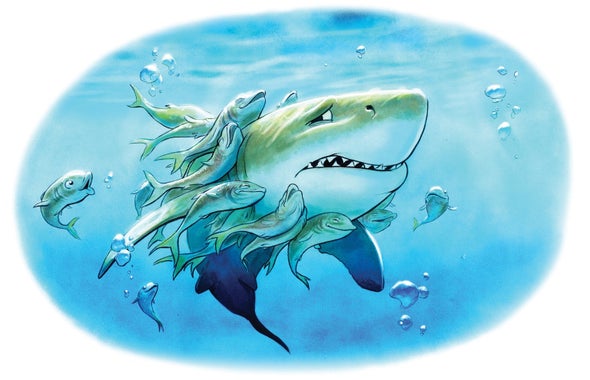Lacey Williams was using a drone to follow a great white shark in South Africa’s Plettenberg Bay when she saw something very strange. As the predator passed a school of meaty leerfish, they did not turn tail and flee. Instead they actively pursued the shark—and began rubbing their bodies against its tail as though it were an exfoliating pumice stone. “All of a sudden, the fish start chafing on the shark,” says Williams, a marine biology graduate student at the University of Miami. “We were just really gobsmacked.”
As the field season wore on, Williams and fellow graduate student Alexandra Anstett observed this behavior again and again. “We’d just kind of see it opportunistically,” Anstett says. Even though shark chafing was not the researchers’ focus, their happenstance observations “raised a ton of questions,” she says. After all, “you don’t see a lion’s prey scratching up against a lion.”
Numerous past studies have confirmed that a whole host of marine organisms, including sharks, chafe on sand and rocks—presumably to remove parasites and bacteria. In a few instances, barracuda have been seen chafing on sea turtles. But even though divers, fishers and scientists had anecdotally reported fish chafing on sharks before, no one had ever undertaken a formal study of this particular behavior.
To fill that gap, Williams and Anstett compiled all the records they could uncover of shark chafing, publishing them online in October in Ecology. As they report, fish-on-shark chafing is a more pervasive and widespread behavior than previously recognized—suggesting an intriguing new ecological relationship that scientists can now begin to explore. “This is a really ubiquitous, common behavior,” Williams says, “so it must serve some ecological function to have evolved across so many species.”
She and Anstett collaborated with experts from several countries and nonprofit organizations to source records of the behavior, including drone footage, photographs, diver video feeds and anecdotal reports. They eventually compiled 47 incidents involving eight different shark species being chafed by 12 species of fish and one species of shark (the latter being silky sharks that were seen rubbing against a whale shark). These examples spanned 13 locations in three oceans from Massachusetts to Mexico and from the Galápagos to California.
The duration of the chafing events ranged from a fleeting eight seconds to more than five minutes. Sometimes a lone fish was involved; at other times, a whole school of 100 or more individuals took part. Some sharks seemed not to care that they were being used as a living back scratcher, while others—specifically, some of the great white sharks—contorted, wiggled their bodies or did corkscrew dives, seemingly trying to shake the other fish off. Somewhat unexpectedly, the researchers never observed any sharks trying to eat the brazen fish. Williams and Anstett guess this may be because sharks usually avoid chasing healthy prey, instead focusing on easier marks that will require less effort to catch. “It could simply be a matter of energy conservation,” Williams says. “Or it’s also possible that we just never were at the right place at the right time to witness” a fish being pursued and eaten.
Jonathan Balcombe, an independent animal behavior biologist and author of What a Fish Knows, says that “it’s good to see these preliminary efforts to describe, quantify and explain” the phenomenon of fish and smaller sharks rubbing against the bodies of larger sharks. “As a general observation, this chafing behavior is consistent with the awareness, intelligence and opportunism of fishes as shown by a growing body of research on their cognitive and emotional capacities,” adds Balcombe, who was not involved in the new study.
One possible explanation the study authors did not mention, he continues, is that fish may be rubbing against sharks’ sandpaperlike skin for simple pleasure. “It’s hardly a secret that terrestrial animals love to rub their bodies against rough objects to relieve an itch,” he says, and there is also “both anecdotal and scientific support for a therapeutic role of touch in relieving stress in fishes and other taxa.”
The authors acknowledge that the study raises many more questions than it answers—including whether sharks get any benefit or harm from chafing and why fish are specifically choosing sharks to rub against rather than sticking with inert (and seemingly much safer) rocks or sand.
Ultimately, Williams and Anstett hope their study piques other scientists’ interest to investigate these questions while also strengthening public interest in ocean life. “Whatever the significance may be, because this behavior can so readily be seen, it’s a way to get others excited about the natural world,” Williams says. “It’s a joy to be able to share our love of sharks and the marine environment.”
A version of this article with the title “Shark Feels” was adapted for inclusion in the February 2022 issue of Scientific American.


